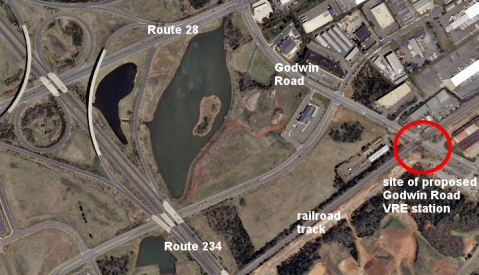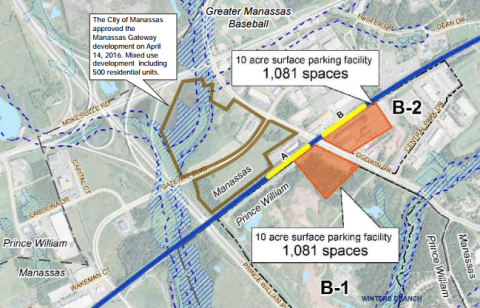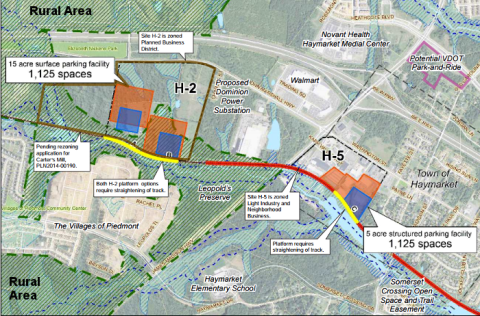Archive for the ‘Rural Crescent’ Category
Things to Consider re: Mid-County Park and Estate Homes Comprehensive Plan Amendment on March 6, 2018
 – This is not a proposal from a long-time landowner who was affected by 1998 Comp Plan. The developer made a speculative gamble when he bought the land in 2003. He knew then that 118 homes, as proposed, far exceeded the zoning or the development projected in the future in the Comprehensive Plan.
– This is not a proposal from a long-time landowner who was affected by 1998 Comp Plan. The developer made a speculative gamble when he bought the land in 2003. He knew then that 118 homes, as proposed, far exceeded the zoning or the development projected in the future in the Comprehensive Plan.
– The Development Area and the Rural Area, defined in the 1998 Comprehensive Plan, were intended to remain separated by a permanent urban growth boundary. Prince William County reviews and updates its Comprehensive Plan every 10 years. Previous plan revisions had expanded the area to be developed, but in 1998 the supervisors “drew the line.” They decided to stop extending sewer lines further away from the waste treatment plants.
The decision to adopt a permanent urban growth boundary was designed to steer development in future decades by upgrading public infrastructure within the Development Area. The 10-acre lot size in the Rural Area was designed to keep the area as a permanent, low-density rural area. The adoption of the urban growth boundary ended the old pattern of treating the western part of the county as a “land bank,” with new development to be authorized later.
– The Mid-County Park and Estate Homes proposal is not a “good project.” It is a camel’s nose, inviting every other developer to propose future amendments to extend sewer lines and developer denser subdivisions with more houses across the entire Rural Area. That might enrich some land speculators, but would defeat the benefits of the urban growth boundary, require higher taxes to pay for widening roads and building more public infrastructure. High-priced houses at Mid-County Park and Estate Homes will still trigger tax increases, as more proposals for sewers and houses leads to sprawl and future road bonds.
– This plan is inconsistent with the county’s requirements for initiating a Comprehensive Plan Amendment:
Economic Development Opportunities: this housing development is not an economic development project involving targeted industries, and will not attract companies or bring new professional and other high-paying jobs
Diversity of Housing: proposes just more of the same, more single-family residences in an area of single-family residences
Transit-Oriented Development: development would not be transit-compatible because density is too low and location is not within walking distance of PRTC bus stop or VRE station.
Compatible Land Uses: Long Branch forms the boundary between Rural Area and Development Area, so it encroaches across the boundary and is incompatible with Rural Area designation
Environment and Open Space: Extending sewer and tripling the number of houses does not protect the environment or maintain open space. Clustering 33 houses on the property would be environmentally sensitive, but building 108 houses in any configuration here fails to protect the resources.
Mixed-Use Neighborhoods: this project is the exact opposite of the mixed use, live-work-play communities envisioned in the county’s Strategic Plan and Comprehensive Plan
Public Services in the Development Area: this project is the exact opposite of the strategy to locate future public services within the Development Area, giving priority to areas of economic development or redevelopment initiatives.
Adequate Level of Service: this project is outside a “small area plan” boundary, so the developer is no longer required to proffer any mitigation of impacts on schools, transportation, or other public services
Road, Pedestrian, and Transit Facilities: this project will put another 100 cars/hour on the road at rush hour, adding to traffic congestion
Sector Plans: this project is an isolated proposal, a stand-alone exercise outside of the sector plans and small area plans used to address proposed changes in land use in a coordinated way
Quality of Life: this project simply expands suburban sprawl, damaging the Rural Area and failing to move Prince William forward towards its vision as a distinctive, live-work-plan community
– The Rural Preservation Study does not justify the Mid-County Park and Estate Homes Comprehensive Plan Amendment. The Rural Preservation Study is just a contractor’s deliverable, and has been sitting on a shelf in the Planning Office since 2014. It has never been adopted by the Planning Commission or the Board of County Supervisors. It is not part of the Comprehensive Plan, and is not a valid basis for amending it. The Rural Preservation Study might be relevant for the update of the Comprehensive Plan in 2019 – but in that case, an equivalent Development Area Study should also be completed.
– Adding sewer and houses in the Rural Area is development, not Rural Area Preservation.
When There Is Not Enough $$$ in the Budget – Why Add More Work, Now?
 On March 6, the Board of County Supervisors will be asked to transfer $100,000 to the Planning Office
On March 6, the Board of County Supervisors will be asked to transfer $100,000 to the Planning Office
In 2016, the supervisors directed the planning staff to complete 9 “Small Area Plans” as part of the Comprehensive Plan update. However, there are not enough planners working for the county to do all that planning.
Logically enough, the Planning Department has requested extra funding to hire consultants. With $100,000 in extra resources, the Planning Office can complete preparations and the supervisors can vote as scheduled in 2019 on the update of the Comprehensive Plan.
So… why would the supervisors add an extra straw to the camel’s back and initiate the proposed MidCounty Park and Estate Homes Comprehensive Plan Amendment on March 6?
Who will pay for the staff to do the extra work for this amendment, one year before the scheduled update of the entire plan?
What’s the logic of doing another amendment to the Comprehensive Plan, now?
Yup, the Camel Will Try to Stick Its Nose Into the Tent on March 6, 2018
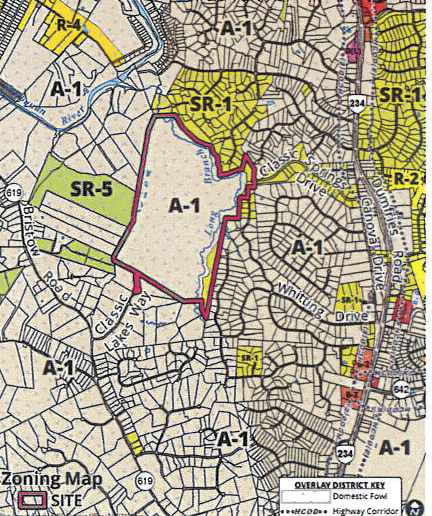 For the third time, for the third time, yes for the third time a developer is asking the supervisors to initiate the Mid-County Park & Estate Homes Comprehensive Plan Amendment.
For the third time, for the third time, yes for the third time a developer is asking the supervisors to initiate the Mid-County Park & Estate Homes Comprehensive Plan Amendment.
That would allow building 118 houses. Since 32-33 houses have been authorized there since 1998, the developer is asking for a massive increase in density.
Busting the Rural Area boundary would ignore the county’s long-term growth strategy in the Strategic Plan and the Comprehensive Plan. It’s an outdated, dumb growth, get-rich-at-the-expense-of-the-taxpayer proposal.
County supervisors determined in 1998 that the suburban sprawl which started after World War II was no longer acceptable. Taxes were climbing too high, traffic congestion was increasing, and something had to be done.
The “something” was a long-term solution to a long-term problem. The 1998 Comprehensive Plan established a long-term urban growth boundary.
It defined a Rural Area for low-density development, and a Development Area where it would be cost-effective to provide public services for new houses. As the county’s population increased, supervisors would need to fund new infrastructure – but concentrating it in the Development Area would minimize the need to raise property taxes.
In 2008, the last update of the Comprehensive Plan re-affirmed the benefits of maintaining the urban growth boundary.
Shaping growth is a long-term game. County supervisors use Comprehensive Plans to shape how the county should evolve in the next 20 years. The plans get technical updates regularly, and a thorough review every ten years.
Next update, due to be completed in 2019, will require another defense of the urban growth boundary.
Obviously, some land speculators hope to re-start sprawl on March 6, without even waiting for the discussion that’s scheduled for the Comprehensive Plan update next year. Does anyone think the Mid-County Park & Estate Homes proposal will be the only request to add more houses in the Rural Area, and abandon the Strategic Plan?
If we start scattered residential development now, we will add traffic on our rural roads. Funding to widen local roads will never get ranked high enough to qualify for state and Northern Virginia Transportation Authority (NVTA) funding, so sprawl will force the county to issue road bonds again and pay extra taxes again. It will be 1998, all over again.
Sprawl raises taxes – so if you want to protect the Rural Area and your wallet, tell your supervisors how you feel.
Supervisors are scheduled to decide on this Comprehensive Plan Amendment at the 2:00pm meeting on March 6.
If you want to share your perspective in advance, you can contact Corey Stewart, Frank Principi, Ruth Anderson, John Jenkins, Pete Candland, Maureen Caddigan, Jeanine Lawson, and Marty Nohe at
cstewart@pwcgov.org, fprincipi@pwcgov.org, randerson@pwcgov.org, jjenkins@pwcgov.org, gainesville@pwcgov.org, mcaddigan@pwcgov.org, jlawson@pwcgov.org, mnohe@pwcgov.org
What We Told the Board of County Supervisors re: Mid-County Park & Estate Homes Comprehensive Plan Amendment
Dear Supervisors,
The Prince William Conservation Alliance supports implementation of the county’s Strategic Vision, to create live-work-play communities in Prince William. We support increasing jobs within our county, by encouraging growth at places such as Innovation and along Route 1.
Prince William Conservation Alliance supports minimizing future traffic congestion by constructing new housing on transit corridors in the Development Area closest to the job centers in Fairfax, Arlington, and the District of Columbia.
We support investing in new public facilities where they can serve the greatest number of people at the lowest cost, in the area designated for development since 1998.
We support lower property taxes, by incentivizing growth in the Development Area where it is cost-effective to provide new fire/police stations, schools, libraries, and other services that must be expanded as population grows.
We support designating agriculture and agri-tourism as a “targeted industry” for economic development in that part of our county furthest away from the job centers, maintaining it as our Rural Area.
We encourage you to do the same, by rejecting the proposal to initiate the Mid-County Park & Estate Homes Comprehensive Plan Amendment on March 6. Do not add more houses in the Rural Area. Do not bust the urban growth boundary that has existed in every Comprehensive Plan and was formally adopted in 1998.
Our county’s Strategic Plan highlights that quality of life is a primary factor that “families, individuals and businesses rely upon when choosing where to locate…” The
Comprehensive Plan is designed for Prince William to evolve into “a role model in many areas… from the provision of public services to protecting our natural resources.”
That requires steering development in the Development Area, and protecting the Rural Area. The alternative is to encourage suburban sprawl. In 1998 the supervisors recognized that sprawl development sabotages transit, raises property taxes, increases traffic congestion, and reduces the distinctive quality of life that makes Prince William competitive when recruiting businesses to provide local jobs.
There are costs, and there are no benefits for the public, if you abandon the growth strategy used for the last 20 years. Stay the course.
Save the Rural Area (Again!) on March 6
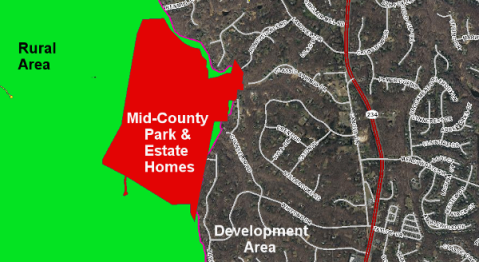
On March 6, the county supervisors are poised to decide on yet another attack against the urban growth boundary adopted in 1998.
A developer has requested a Comprehensive Plan Amendment for a subdivision in the Rural Area,. According to the Generalized Development Plan, 108 118 houses could be constructed on a parcel planned for 32 homes.
Supervisor’s vote is reportedly scheduled for March 6, though that agenda item is not formally locked in yet.
The “Mid-County Park & Estate Homes” proposal is the third attempt to bust the Rural Area boundary at that site. The developer purchased the land in 2003, long after he knew the allowed density was for 32 homes.
You can make a nice profit building 32 homes on property bought with the land prices from 15 years ago. Evidently, a nice land speculation profit is not enough for some developers. The county’s zoning on that parcel has been in place for two decades, but he dreams of even more, more, more houses.
Supervisors previously rejected amending the Comprehensive Plan at this site because adding 76 unplanned houses there would provide no public benefits. The private developer would get windfall benefits, while the public would get stuck with the costs of sprawl.
Sprawl is “dumb growth.” It ultimately increases property taxes, because it is more expensive to provide public services (fire/police stations, for example).
That’s why the supervisors adopted the Rural Area and Development Area boundaries in 1998. Voters were aroused by steadily increasing property taxes. The county’s population had boomed, and it was clear that focusing growth in the Development Area would minimize the costs to provide new public infrastructure.
Now the supervisors are being asked to change the course followed for the last 20 years, start allowing unplanned growth in the Rural Area, and eventually increase property taxes to support scattered development.
The “Mid-County Park & Estate Homes” development being considered on March 6 is not a proposal for a park. It’s a proposal to authorize unplanned houses, to trigger a surge of land speculation in the Rural Area, and to repeat the tax headache face by supervisors in 1998.
The supervisors should reject this development proposal – for the third time.


Community: 1, Buckland Bypass: 0
 The room at Haymarket Elementary was packed with 150+ people. A significant percentage wore T-shirts expressing opposition to the latest proposal for a Buckland Bypass,a 4-lane divided highway west of Haymarket. concerned that Prince William County was proposing (again) to build a Buckland Bypass.
The room at Haymarket Elementary was packed with 150+ people. A significant percentage wore T-shirts expressing opposition to the latest proposal for a Buckland Bypass,a 4-lane divided highway west of Haymarket. concerned that Prince William County was proposing (again) to build a Buckland Bypass.
Fauquier officials made clear that they did not support the Buckland Bypass (which would start in their county) now, and never have.
The residents of Cerro Gordo and nearby neighborhoods made their points clearly, politely, forcefully, and successfully last night. All but perhaps one were clearly opposed. The road would displace residents, transform the character of the neighborhoods, potentially dry up wells – and the costs would far exceed the benefits.
Jeanine Lawson, Brentsville District Supervisor, commented that they “killed it.” She predicted with confidence that there will be no Comprehensive Plan Amendment to initiate a Buckland Bypass.
Earlier in 2017, the county floated a proposal for a new highway linking Route 29 and I-66, so commuters driving north from Stafford, Culpeper, and Fauquier would be able to cut through Prince William’s Rural Area in order to get to work.

The county’s project was an echo of previous proposals for a Western Bypass or Outer Beltway. Various versions of new roads have been justified by the supposed need to get heavy trucks from I-95 to I-81 quicker, or to move commuters to the west before they drive eastward towards DC, or… well, pick a rationalization, they’re all equally valid.
The fundamental push has been from developers who want to by land cheap, get it rezoned to “bust” the Rural Area protections, and then build more subdivisions. If only the government would build new roads, then traffic congestion would simply evaporate. Then everyone would support more residential development on the periphery of the urban core, right?
Reality suggests otherwise. I-66 has been widened to Haymarket, and a new interchange completed. A new Route 29 interchange at Linton Hall has been built. That did not cause traffic to evaporate – and the “just build more roads; that will fix it this time” argument failed last night.
The Buckland Bypass was only a skirmish. It can be compared to the Buckland Races in 1863 – important for those directly affected, but not a conclusive engagement in the war. The real challenge, protecting the Rural Area, still lies ahead.
 proposed “short routes” discussed at the October 10 Stakeholder’s Meeting
proposed “short routes” discussed at the October 10 Stakeholder’s Meeting
VDOT Tries Sneak Attack – Again – for New Roads West of Haymarket
The Virginia Department of Transportation (VDOT) is engaged in another hide-and-seek exercise to facilitate sprawl west of Haymarket. They’re back, trying to build new roads west of Haymarket that are not in the county’s Comprehensive Plan.
The game plan is to use the massive “Transform I-66” project as an excuse to extend Heathcote Boulevard west, and build a bridge over I-66 connecting Heathcote to Route 55 near the Amazon data center.
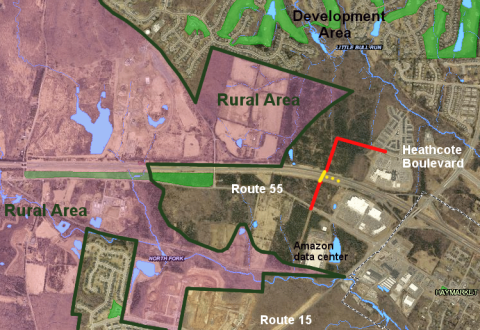
new roads are in red, and the new bridge with HOT ramps is in yellow
As they say on TV – but wait, there’s more. Prince William County has already restarted a study of another road, the developers’ dream known as the Buckland Bypass. It would run from Fauquier County north along the edge of the Bull Run Mountains.
If a 4-lane divided highway replaced Thoroughfare Road south of I-66, how long before there’s a proposal to widen Antioch Road and build a 4-lane road parallel to Route 15 at the base of Bull Run Mountain north to Loudoun County? It’s another flavor of the Bi-County Parkway nightmare.
Once again, VDOT is not being transparent or straight-up i n its Transform I-66 planning. The next round of I-66 public discussion, the Concept Plan meetings scheduled in June, has no discussion of any new construction west of Route 29.
n its Transform I-66 planning. The next round of I-66 public discussion, the Concept Plan meetings scheduled in June, has no discussion of any new construction west of Route 29.
The VDOT public involvement process is “Hey folks, look this way, to the east… no no no, don’t look at what we’re planning west of Route 29 until it’s too late to change anything.”
VDOT’s Concept Plan public meetings in June resemble the way magicians do something flashy to draw the audience’s attention to one side of the stage, while stuffing a rabbit into the hat.
This is not VDOT’s first magician show on expanding roads west of Route 15. In 2015, after finishing all the public events to discuss how to improve I-66, the state transportation agency tried to sneak into the plan a new parking lot on Antioch Road, replacing an operating local farm with pavement.
The public response, including a resolution by the Board of County Supervisors to save the Heflin Farm, was quick and loud. The parking lot was dropped before the I-66 project was approved by the Virginia Commonwealth Transportation Board (CTB).
Now it’s back, though hidden quite well. You have until midnight, April 8 to submit your comments on this latest attempt. Yup, the deadline is that tight.
Continue reading
How Many Cars Would VRE Extension to Gainesville-Haymarket Remove From I-66? You Do the Math
 VRE responded to the blog post VRE Extension to Haymarket Proposes to Remove 100 Cars/Day from I-66… At Cost of $468 Million.
VRE responded to the blog post VRE Extension to Haymarket Proposes to Remove 100 Cars/Day from I-66… At Cost of $468 Million.
They said:
“The statement that the extension alternative ‘only removes 100 more cars’ compared to the enhanced Broad Run alternative is not correct and is not based on the information presented by VRE. There was discussion during the public meeting of projected ridership and related savings in automobile vehicle miles traveled, or VMT. The 2025 ridership estimates presented for the Manassas Line show a difference of 600 riders for a Broad Run terminus (13,200) versus a Haymarket terminus (13,800). The Haymarket extension alternative would save corridor commuters 88,600 daily VMT, while the Broad Run alternative would save 31,300 VMT.”
True, VRE did not provide the 100 cars/day number at the public meetings – but that 100 cars/day number is based on the information presented by VRE.
To help you do the math on your own without waiting for VRE to unveil this key statistic:
– 600 riders equals 300 cars in the morning and 300 cars in the evening, if everyone drives alone.
– 600 riders equals 100 cars in the morning and 100 cars in the evening, if each is carrying three people to avoid the toll after I-66 is “improved” with new toll lanes.
VRE’s numbers about Vehicle Miles Traveled (VMT) are not the same as the number of cars/day. Do not confuse the VMT numbers with the number of cars removed from I-66.
The VMT numbers do provide some insight. One car going from Gainesville to DC travels about 34 miles inbound and 34 miles coming home, or 68 VMT per day. The difference between retaining the existing Broad Run station vs. building three stations to Haymarket would be 55,300VMT/day, counting both inbound-in-the-morning and outbound-in-the-afternoon travel.
At 68 VMT per vehicle per day, assuming everyone drove solo and paid the tolls required to travel on I-66 inside the Beltway, that equals 55,300VMT/68VMT per day. That would be 813 cars/day.
If drivers chose to avoid tolls and carried two passengers, the the HOV3 number would be 813/3 or 271 cars/day.
VRE is an effective way to move commuters from the periphery into the urban core. According to VRE’s presentation at the April 27 community meeting, each train carries 1,000 passengers and each lane of I-66 carries 2,000 vehicles/hour. (Each car carries about 100 passengers, so VRE’s numbers assume 10-car trains.)
If the four VRE trains leaving Broad Run between 6:15am and 7:48am were completely full, They would reduce congestion on I-66 during that 90-minute period by 4,000 passengers. That would be equivalent to 1,333 cars if each carried 3 people, or 4,000 cars if everyone was driving solo, or about 75 OmniRide buses.
The overall VRE system itself is an effective way to transport commuters. It is the proposed extension to Gainesville-Haymarket that fails the cost-effectiveness test. At $468 million to remove 100, 271, or even 813 cars/day… surely there is a better way to spend the taxes raised by the 2013 General Assembly to reduce traffic congestion.
Changing the VRE Manassas Line: Exploring the Godwin Road Station Alternative
The Virginia Railway Express (VRE) is exploring if it should extend the line that runs from Broad Run through Manassas to Union Station, as well as add three new trains to carry commuters into DC each morning.
The “full bore” expansion option is to build new stations at Innovation, Gainesville, and Haymarket, while closing the existing Broad Run station and the end of the Manassas Line That would require adding a second (and potentially a third) railroad track for the 11 miles to Haymarket, plus construction of a new railyard west of that town.
Compared to the “minimal change” alternative of adding the three new trains but maintaining the existing station at Broad Run, constructing a new 11-mile extension to Haymarket would cost an additional $250-$350 million. Despite the expense for the additional infrastructure, VRE would carry only an additional 300 daily commuters each way in 2025 compared to the “minimal change” alternative.
Adding additional trains but still using the Broad Run station would provide a better benefit/cost ratio than the alternative of building three new stations, new tracks, and a new railyard near Haymarket. However, retaining the Broad Run station would create a major problem with train storage.
The railyard at Broad Run is limited in size. The current passenger platform blocks addition of the extra storage tracks that would be necessary, if VRE added three additional trains in each direction.
A third alternative, costing perhaps $10 million more than the “minimal change” option, is to build a new station where the railroad crosses Godwin Road in Manassas.
Godwin Road would become the end-of-line station and the platform at Broad Run would be closed. The Godwin Road alternative would allow expansion of the existing railyard.
It would cost far less to implement the Godwin Road alternative, compared to the high costs of building an extension to Haymarket with three new stations and a new railyard . A Godwin Road end-of-line station would also minimize annual operating costs, since the trains in the yard would be located just 1.5 miles away from the location where service starts/ends each day.
Most significantly, a station at Godwin Road is not underneath the flight path of Manassas Airport. Unlike Broad Run, the new end-of-line station could trigger transit-oriented development and create economic benefits consistent with the City of Manassas Comprehensive Plan.
The Manassas Landing area is described as a “gateway” for development. Placing a VRE station there could result in high-tech companies choosing to locate there. Adding more trains to VRE would offer the potential for skilled workers living within the urban core to commute to jobs in Manassas without using a car.
Planning for growth at Godwin Road provides a clear contrast to the planning by Prince William County for the land west of Haymarket. VRE has proposed a new station located west of Route 15, but at that site the station would be located within the Rural Area.
The Rural Area is supposed to be a zone of low density development. Unless current land use planning is ignored in order to speculate on rezonings that would transform the area, there would be few (if any) economic benefits for a new VRE station located west of Haymarket.
Madera Farm – The Backstory
January 20, 2016 UPDATE: The Board of County Supervisors approved the addition of Madera to the Agricultural and Forestal District on January 19 in a 7-0 vote, but only after the landowner committed to cancel the request for a Special Use Permit.
The Gainesville District supervisor negotiated that in advance. The Prince William Conservation Alliance spoke at the public hearing in support of commercial agriculture, rather than industrial operations, in the Rural Area.
Normally, adding a farm in western Prince William’s Rural Area to an Agricultural and Forestal District would be a routine event. The county established that land use classification in 1973 to facilitate preservation of farms and forests.
However, Madera “Farm” is not a normal agricultural operation. It resembles more closely an industrial operation, grinding mulch and processing construction and demolition debris.

Adding Madera to an adjacent Agricultural and Forestal District would undercut efforts to maintain commercial agricultural operations in Prince William County. It would reduce the credibility of actual farmers working to preserve farmland, and open the door to increased housing and retail strip shopping districts in the county’s Rural Area. Continue reading
 Comments (2)
Comments (2)
